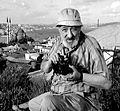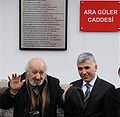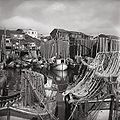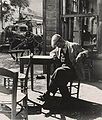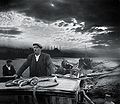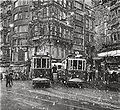Гюлер Ара — различия между версиями
Ssayadov (обсуждение | вклад) (→Персональные фото) |
|||
| (не показаны 34 промежуточные версии 6 участников) | |||
| Строка 1: | Строка 1: | ||
| − | {{ | + | {{Персона |
| + | | name-ru-main = Гюлер Ара | ||
| + | | name-ru-01 = «Око Стамбула» (прозвище) | ||
| + | | name-ru-02 = | ||
| + | | name-ru-03 = | ||
| + | | name-lat = Ara Güler | ||
| + | | name-en = Guler Ara | ||
| + | | name-am = | ||
| + | | name-fr = | ||
| + | | состояние текста = 7 | ||
| + | | состояние поиска = 7 | ||
| + | | состояние тэгов = 7 | ||
| + | | состояние ссылок = 7 | ||
| + | | флаг чистовик = 7 | ||
| + | | портрет = Ара Гюлер1.jpg | ||
| + | | дата рождения = 16.08.1928 | ||
| + | | место рождения = Стамбул, Турция | ||
| + | | дата смерти = | ||
| + | | место смерти = | ||
| + | | место деятельности = | ||
| + | | краткая информация = Фотограф | ||
| + | | тэг01 = Фотограф | ||
| + | | тэг02 = орден Почётного легиона | ||
| + | | тэг03 = премия «Lucie» | ||
| + | | тэг04 = почетный доктор | ||
| + | | тэг05 = | ||
| + | }} | ||
| + | =Биография= | ||
| + | Ара Гюлер родился в 1928-м году, в Стамбуле, в семье этнических армян. <ref>У его отца, владельца аптеки на «Istiklal Avenue», было много друзей из мира искусства того времени. Раннее общение с этими людьми вызвало у Ары желание построить карьеру в кино. Будучи студентом, он подрабатывал в киностудиях и посещал драмкружок, устраиваемый Мухсином Эртугрулом, основателем современного турецкого театра.</ref> | ||
| − | Гюлер | + | В 1950-м году Ара Гюлер решил переключиться в своих интересах с кино на журналистику: он устроился в газету «Yeni Istanbul» фотокорреспондентом. В это время он уже обучался экономике в Университете Стамбула. Через какое-то время он перевёлся в другое издание, в газету «Hürriyet». |
| − | + | В 1958-м году американский издательский дом «Time-Life» открыл филиал в Турции, и Гюлер стал его первым корреспондентом на Ближнем Востоке. Вскоре он начал получать задания и от других международных изданий, таких как «Paris Match», «Stern» и «London Sunday Times». | |
| + | После завершения воинской службы в 1961-м году Ара Гюлер получил работу в турецком журнале «Hayat» в должности шефа фотоотдела. В это время Ара познакомился с Анри Карье-Брессоном и Марком Рибу, которые предложили ему вступить в агентство Магнум. | ||
| + | В 1961-м году работы Ары Гюлера были представлены в британском фотографическом ежегоднике. В том же году он стал единственным турецким членом Американского Общества Журнальных Фотографов (ASMP), а швейцарский журнал «Camera» удостоил его почётного упоминания в специальном выпуске. | ||
| + | Некоторые критики считают, что наиболее выдающиеся работы Ары Гюлера — это его меланхоличные чёрно-белые фотографии, сделанные в Стамбуле, преимущественно с использованием «лейки», в 50-60x годах — золотом веке фотожурналистики. В справочнике Британского журнала фотографии за 1968 года имя Гюлера названо среди семи лучших фотографов мира. В 1962 году он получил награду «Мастер «Лейки». Гюлер участвовал в сотнях выставок по всему миру. | ||
| − | + | В 1975 он был приглашен в США, чтобы фотографировать нескольких известных американцев. Выставка «Творческие американцы», которая возникла из этого путешествия, прошла в нескольких городах мира. Тем временем он фотографировал многочисленных известных персонажей, в том числе Бертрана Рассела, Уинстона Черчилля, Арнольда Тойнби, Пикассо, Сальвадора Дали. Самой важной из этих встреч была встреча с Пикассо, который был известен своими отказами позировать для фотографов. | |
| + | ==Работы Ара Гюлера находятся== | ||
| + | Работы Ара Гюлера находятся в коллекции Французской национальной библиотеки, Коллекции Шелдон университета Небраски, частных коллекциях в Бостоне, Чикаго, Нью-Йорке. Его фотографии экспонируются, в частности, в Музее Людвига в Кельне. К 77 дню рождения Ара Гюлера была приурочена его ретроспективная выставка в Доме фотографии в Стамбуле. | ||
| + | |||
| + | ==Ара Гюлер — мысли вслух== | ||
| + | Ара Гюлер уделяет огромное значение присутствию человека на своих фотографиях и называет себя «визуальным историком». | ||
| + | «Когда я фотографирую Собор Святой Софии, что действительно имеет значение, так это человек проходящий мимо, ведь он значит жизнь», — сказал как-то он. Гюлер считает, что фотография должна хранить воспоминания о человеке, о его жизни и особенно страданиях. В то время как искусство может лгать, фотография, по его мнению, может лишь фиксировать реальность. | ||
| + | Гюлер ценит право называться фотожурналистом, так как он не придаёт особенного значения фотографии как художественному занятию. Он не считает фотографию искусством. | ||
| − | + | ===[[Высказывания маэстро|Высказывания маэстро]]=== | |
| − | |||
| − | + | ==Достижения== | |
| + | *награда «Мастер «Лейки» (1962, эта награда присуждена только 32 фотографам во всем мире) | ||
| + | *назван «Лучшим фотографом века» (Турция, 2000) | ||
| + | *орден Почётного легиона | ||
| + | *премия «Lucie» (2009, считается Оскаром в сфере фотографии) | ||
| + | *почетный доктор турецкого университета искусств Мимара Синана (2013) | ||
| − | + | ==Изображения== | |
| − | + | ===Персональные фото=== | |
| + | <gallery> | ||
| + | Файл:148_1.png | ||
| + | Файл:Ara Guler.jpg | ||
| + | Файл:Ара Гюлер21.jpg | ||
| + | Файл:Ара Гюлер17.jpg | ||
| + | Файл:Ара Гюлер19.jpg | ||
| + | Файл:Ара Гюлер22.JPG | ||
| + | Файл:193Ара Гюлер.jpg | ||
| + | Файл:204Ара Гюлер.jpg | ||
| + | Файл:Ара Гюлер.jpeg|На открытии проспекта в свою честь в г. Шапин Гарахисар | ||
| + | Файл:Ара Гюлер3333.jpg|Турецкий университет искусств Мимара Синана присудил Ара Гюлеру степень почетного доктора. 2013 | ||
| + | Файл:Ara-Guler-1.jpg | ||
| + | </gallery> | ||
| + | ===Портретные фото=== | ||
| + | <gallery> | ||
| + | Файл:Ара Гюлер18.jpg|Дастин Хофман | ||
| + | Файл:Ара Гюлер20.jpg|Уинстон Черчиль | ||
| + | Файл:Ара Гюлер14.jpg|Сальвадор Дали | ||
| + | Файл:Ара Гюлер2.jpg|Параджанов Сергей | ||
| + | </gallery> | ||
| − | Ara | + | ===Жанровые фото=== |
| + | <gallery> | ||
| + | Файл:Ара Гюлер3.jpg | ||
| + | Файл:Ара Гюлер4.jpg | ||
| + | Файл:Ара Гюлер5.jpg | ||
| + | Файл:Ара Гюлер6.jpg | ||
| + | Файл:Ара Гюлер8.jpg | ||
| + | Файл:Ара Гюлер9.jpg | ||
| + | Файл:Ара Гюлер11.jpg | ||
| + | Файл:Ара Гюлер12.jpg | ||
| + | Файл:Ара Гюлер13.jpg | ||
| + | Файл:Ара Гюлер15.jpg | ||
| + | Файл:Ара Гюлер16.jpg | ||
| + | Файл:Ara Guler1.jpg | ||
| + | </gallery> | ||
| − | Ara | + | ==Каталоги фотовыставок== |
| + | * International Photography Year Book Star Photographers, UK and Canada (1961) | ||
| + | * Camera Magazine (Special issue), Lucern, Switzerland (February 1962) | ||
| + | * Leica Fotografie Nr. 2 Germany (1962) | ||
| + | * Katalog, Weltausstellung der Fotografie Fotokina by Dr. Karl Pavek, Cologne, Germany (1963) | ||
| + | * Camera Magazine Nr. 6 (Special Turkish Photography), Switzerland (June 1966) | ||
| + | * Sunday Journal Lincoln, Nebraska, USA (September 11, 1966) | ||
| + | * British Journal of Photography Annual , London, UK (1967) | ||
| + | * Photography of the World Orion Press, Tokyo, Japan (1967) | ||
| + | * 2. Weltausstellung der Fotografie, "Die Frau" by Dr. Karl Pavek, Cologne, Germany (1968) | ||
| + | * Photographie Italiana by Lanfranco Colombo, p. 127, Milano, Italy (March 1968) | ||
| + | * Photographare Magazine by Romanof Fea, Rome, Italy (November 1968) | ||
| + | * Historie de la Photographie "Quw Sais-je?" by Jean A.Leim, Press Universitaire de France | ||
| + | * Milliyet Sanat Dergisi Nr. 2, Istanbul, (October 6, 1972) | ||
| + | * Dora Jane Hamblin, Buried Cities and Ancient Treasures (on Aphrodisias), p. 192, New York: Simon and Schuster, 1973 | ||
| + | * People Magazine , USA, (October 28, 1974) | ||
| + | * Romeo E. Martinez, Creative Americans (Catalogue), USIS (1975) | ||
| + | * Camera Magazine, Elite World Photographers-1 , Lucerne (November 1975) | ||
| + | * Photo Cinema , p. 82, Paris (June 1976) | ||
| + | * Fritz Kempe, Leica Fotografie Nr. 5, Frankfurt, Germany (1976) | ||
| + | * Yeni Fotograf Dergisi , Istanbul (October 1976) | ||
| + | * Camera Magazine Lucerne (February 1977) | ||
| + | * Saudi Gazette Saudi Arabia, (May 1979) | ||
| + | * Fritz Gruber, Dumont Foto 2, Fotokunst und Fotodesign International, Das Antlitz im Wandel der Zeit , Cologne, Germany (1980) | ||
| + | * John Morris, Popular Photography , USA (1980) | ||
| + | * Renate & L. Fritz Gruber, Dumont Foto 3 , Cologne: Das imaginäre Photo-Museum, 1981 | ||
| + | * Photography Annual New York, USA (1981) | ||
| + | * Michelle ve Michael Auer, Photographer's Encyclopedia International Vol. 1, Switzerland, Edition Camera Obscura , 1985 | ||
| + | * Alain Gheerbrant, Catalogue 6emes Journées International de la Photo et de L'audiovisuel by Montpellier, France (1985) | ||
| + | * Leica Fotografie p. 18, Frankfurt, Germany (1987) | ||
| + | * Aamulehti , Tampere, Finland (1989) | ||
| + | * Helsingin Sonamat , Helsinki, Finland (April 1989) | ||
| + | * Kamera Nr. 3, Finland (1989) | ||
| + | * Contreplongee Revue du Cinema et Culture , Nr. 19, Strasbourg, France (March 1990) | ||
| + | * Fotograf Sanat Dergisi Sayı 9, Istanbul, Turkey (June 1989) | ||
| + | * Time & Time International Book Review , Nr. 31, (about the book Sinan ) New York (August 3, 1992) | ||
| + | * Bitmeyen Roportaj Istanbul , (Exposition catalogue), Istanbul, Turkey (April 1993) | ||
| + | * Photographers International Nr. 14,(Chinese - English), Taipei, Taiwan (June 1994) | ||
| + | * Mark Simon, "Ara Güler: Reality, History and Lost Istanbul", PDN - Photo District News Magazine, p. 43, USA, (August 1995) | ||
| + | * Pierre Sorgue, "Pieton d'Istanbul", Méditerranée Magazine, Nr. 13, France (March 1996) | ||
| + | * Ara Güler, "Estambul: La Puerta Del Mas Alla", Matador Magazine, Vol. B, Madrid, 1996 | ||
| + | * Photographie des 20, Jahrhunderts (German), Museum Ludwig Cologne, Cologne: Edition Taschen, 1997 | ||
| + | * Stephen Kinzer, "Turkey's Passionate Interpreter to the World", New York Times , April 13, 1997 | ||
| + | * Stephen Kinzer, "Interpreting Turkey: A Master's Vision", International Herald Tribune , April 16, 1997 | ||
| + | ==Видео== | ||
| + | *[http://www.youtube.com/watch?v=KQKSeKT_hGo Ara Gyuller (2011)] | ||
| + | *[http://www.youtube.com/watch?v=9uLumw9bODY Turkish Photography - Portraits by Ara Guler] | ||
| + | *[http://www.youtube.com/watch?v=uJUnxDaQ068 Kadraj Bolum 46 - Portfolyo 2. Bolum - Ara Guler] | ||
| + | *[http://www.youtube.com/watch?v=XFt1gQ-qqpA 14-11-2009 Ara Guler] | ||
| + | *[http://www.youtube.com/watch?v=enMLR32xYS8 Ara Guler] | ||
| + | *[http://www.dailymotion.com/video/x9mie5_ara-guler-the-world-of-yesterday_creation Ara Guler - "The World Of Yesterday"] | ||
| + | *[http://vimeo.com/6764774 Ara Guler - Portraits de 1957 a 1974] | ||
| + | *[http://www.uzmantv.com/ara-guler-foto-muhabirligine-nasil-basladi Ara Guler foto muhabirligine nas?l baslad??] | ||
| + | *[http://www.youtube.com/watch?v=KQKSeKT_hGo Ара Гюлер / Фильм Мананы Акопян (2011)] | ||
| − | + | ==Разное== | |
| + | *Его фотоархив насчитывает более 800 000 снимков. | ||
| + | *Один из проспектов города Шапин Гарахисар области Гиресун Турции назван в честь Ара Гюлера - всемирно известного константинопольского фотографа и фотожурналиста армянского происхождения (2009). | ||
| + | *Имеет титул - «Лучший фотограф века», известен также как «Глаз Стамбула». | ||
| − | by | + | =Библиография= |
| + | *Армяне-народ созидатель чужих цивилизаций: 1000 известных армян в мировой истории/С.Ширинян.-Ер.: Авт. изд., 2014, стр.291, ISBN 978-9939-0-1120-2 | ||
| + | * Öster om Eufrat, I Kurdernas Land (Swedish) by Barbro Karabuda, Tidens Förlag, Stockholm, Sweden. 1960 | ||
| + | * Marianna Norris, Young Turkey, Children of Turkey at work and at play , (English), New York: Dodd, Mead. 1964 | ||
| + | * Topkapı Sarayı - Sultan Portreleri , (Turkish) Doğan Kardeş Yayınları, Istanbul, Turkey. 1967 | ||
| + | * Turkei , (German) Terra Magica, Munich, Germany. 1970 | ||
| + | * Hagia Sophia , (English) by Lord Kinross, New York: Newsweek Books. 1972 | ||
| + | * The Splendor of Islamic Calligraphy , (English) Thames & Hudson, London, UK. 1976 | ||
| + | * Harems , (English) Chene & Hudson, London, UK. 1976 | ||
| + | * Fotoğraflar , (Turkish) Milliyet Yayınları, Istanbul, Turkey. 1980 | ||
| + | * Turan Erol, Fikret Mualla , (Turkish), Cem Yayınları, Istanbul, Turkey. 1980 | ||
| + | * Turan Erol, Bedri Rahmi , (Turkish), Cem Yayınları, Istanbul, Turkey. 1984 | ||
| + | * Aptullah Kuran , Mimar Sinan (Turkish), Hürriyet Vakfı Yayınları, Istanbul, Turkey. 1986 | ||
| + | * Aptullah Kuran, Mimar Sinan , (English), Washington DC: Institute of Turkish Studies. 1987 | ||
| + | * Ara Güler'in Sinamacıları , (Turkish) Hil Yayınları, Istanbul, Turkey. 1989 | ||
| + | * Halkarnas Balıkçısı (Cevat Şakir Kabaağaçlı), TC Dışişleri, The Sixth Continent , Bakanlığı Kültür Dairesi, Ankara, Turkey. 1991 | ||
| + | * John Freely, Augusto Romano Burelli, Sinan: Architect of Suleyman the Magnificent and the Ottoman Golden Age , (English), London: Thames and Hudson, 1992. ISBN 0-500-34120-6 | ||
| + | * Stephane Yerasimos , Living in Turkey , (English), London and New York: Thames & Hudson, 1992 | ||
| + | * Stephane Yerasimos, Demeures Ottomans de Turquie , (French), Paris: Albin Michel, 1992 | ||
| + | * Stephane Yerasimos, Turkish Style ,(English), Singapore: Archipelago Press, 1992 | ||
| + | * Eski İstanbul Anıları , (Turkish), Dünya Şirketler Grubu, Istanbul, Turkey. 1994 | ||
| + | * A Photographical Sketch on Lost Istanbul , (English), Dünya Şirketler Grubu, Istanbul, Turkey. 1994 | ||
| + | * Bir Devir Böyle Geçti, Kalanlara Selam Olsun , (Turkish), Ana Yayıncılık, Istanbul, Turkey. 1994 | ||
| + | * Yitirilmiş Renkler , (Turkish), Dünya Şirketler Grubu, İstanbul, Turkey. 1995 | ||
| + | * Yüzlerinde Yeryüzü (Turkish), Ana Yayıncılık, Istanbul, Turkey. 1995 | ||
| + | * Babil'den Sonra Yaşayacağız , (Turkish) Aras Yayınları, Istanbul, Turkey. 1996 | ||
| + | *[http://armeniangc.com/2014/05/fotografii-anatolii-ara-gyulera/ В поисках утраченного: Фотографии Анатолии Ара Гюлера подняли вопрос о турецкой идентичности и истории] | ||
| + | *[http://www.araguler.com.tr/ Персональный сайт] | ||
| + | *[http://www.armeniapedia.org/index.php?title=Ara_Guler armeniapedia] | ||
| + | *[http://www.turkevim.com/publ/5-1-0-23 TURK EVIM - ТУРЕЦКИЙ ДОМ] | ||
| + | *[http://www.fotograf.net/araguler/ Ara Guler] | ||
| − | + | ==Сноски== | |
| − | + | <references/> | |
| − | |||
| − | |||
| − | |||
| − | |||
| − | |||
| − | |||
| − | |||
| − | |||
| − | |||
| − | |||
| − | |||
| − | |||
| − | |||
| − | |||
| − | |||
| − | |||
| − | |||
| − | |||
| − | |||
| − | |||
| − | |||
| − | |||
| − | |||
| − | |||
| − | |||
| − | |||
| − | |||
| − | |||
| − | |||
| − | |||
| − | |||
| − | |||
| − | |||
| − | |||
| − | |||
| − | |||
| − | |||
| − | |||
| − | |||
| − | |||
| − | |||
| − | |||
| − | |||
| − | |||
| − | |||
| − | |||
| − | |||
| − | |||
| − | |||
| − | |||
| − | |||
| − | |||
| − | |||
| − | |||
| − | |||
| − | |||
| − | |||
| − | |||
| − | |||
| − | |||
| − | |||
| − | |||
| − | |||
| − | |||
| − | |||
| − | |||
| − | |||
| − | |||
| − | |||
| − | |||
| − | |||
| − | |||
| − | |||
| − | |||
| − | |||
| − | |||
| − | |||
| − | |||
| − | |||
| − | |||
| − | |||
| − | |||
| − | |||
| − | |||
| − | |||
| − | |||
| − | |||
| − | |||
| − | |||
| − | |||
| − | |||
| − | |||
| − | |||
| − | |||
| − | |||
| − | |||
| − | |||
| − | |||
| − | |||
| − | |||
| − | |||
| − | |||
| − | |||
| − | |||
| − | |||
| − | |||
| − | |||
| − | |||
| − | |||
| − | |||
| − | |||
| − | |||
| − | |||
| − | |||
| − | |||
| − | |||
| − | |||
| − | |||
Текущая версия на 23:20, 30 марта 2015
| Гюлер Ара | |
| Guler Ara | |
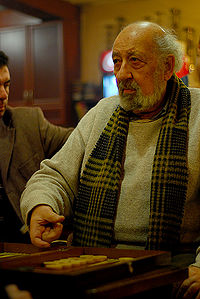
| |
| Другие имена: | «Око Стамбула» (прозвище) |
| Латиницей: | Ara Güler |
| На английском: | Guler Ara |
| Дата рождения: | 16.08.1928 |
| Место рождения: | Стамбул, Турция |
| Краткая информация: Фотограф | |
Содержание
Биография
Ара Гюлер родился в 1928-м году, в Стамбуле, в семье этнических армян. [1]
В 1950-м году Ара Гюлер решил переключиться в своих интересах с кино на журналистику: он устроился в газету «Yeni Istanbul» фотокорреспондентом. В это время он уже обучался экономике в Университете Стамбула. Через какое-то время он перевёлся в другое издание, в газету «Hürriyet».
В 1958-м году американский издательский дом «Time-Life» открыл филиал в Турции, и Гюлер стал его первым корреспондентом на Ближнем Востоке. Вскоре он начал получать задания и от других международных изданий, таких как «Paris Match», «Stern» и «London Sunday Times».
После завершения воинской службы в 1961-м году Ара Гюлер получил работу в турецком журнале «Hayat» в должности шефа фотоотдела. В это время Ара познакомился с Анри Карье-Брессоном и Марком Рибу, которые предложили ему вступить в агентство Магнум.
В 1961-м году работы Ары Гюлера были представлены в британском фотографическом ежегоднике. В том же году он стал единственным турецким членом Американского Общества Журнальных Фотографов (ASMP), а швейцарский журнал «Camera» удостоил его почётного упоминания в специальном выпуске.
Некоторые критики считают, что наиболее выдающиеся работы Ары Гюлера — это его меланхоличные чёрно-белые фотографии, сделанные в Стамбуле, преимущественно с использованием «лейки», в 50-60x годах — золотом веке фотожурналистики. В справочнике Британского журнала фотографии за 1968 года имя Гюлера названо среди семи лучших фотографов мира. В 1962 году он получил награду «Мастер «Лейки». Гюлер участвовал в сотнях выставок по всему миру.
В 1975 он был приглашен в США, чтобы фотографировать нескольких известных американцев. Выставка «Творческие американцы», которая возникла из этого путешествия, прошла в нескольких городах мира. Тем временем он фотографировал многочисленных известных персонажей, в том числе Бертрана Рассела, Уинстона Черчилля, Арнольда Тойнби, Пикассо, Сальвадора Дали. Самой важной из этих встреч была встреча с Пикассо, который был известен своими отказами позировать для фотографов.
Работы Ара Гюлера находятся
Работы Ара Гюлера находятся в коллекции Французской национальной библиотеки, Коллекции Шелдон университета Небраски, частных коллекциях в Бостоне, Чикаго, Нью-Йорке. Его фотографии экспонируются, в частности, в Музее Людвига в Кельне. К 77 дню рождения Ара Гюлера была приурочена его ретроспективная выставка в Доме фотографии в Стамбуле.
Ара Гюлер — мысли вслух
Ара Гюлер уделяет огромное значение присутствию человека на своих фотографиях и называет себя «визуальным историком».
«Когда я фотографирую Собор Святой Софии, что действительно имеет значение, так это человек проходящий мимо, ведь он значит жизнь», — сказал как-то он. Гюлер считает, что фотография должна хранить воспоминания о человеке, о его жизни и особенно страданиях. В то время как искусство может лгать, фотография, по его мнению, может лишь фиксировать реальность.
Гюлер ценит право называться фотожурналистом, так как он не придаёт особенного значения фотографии как художественному занятию. Он не считает фотографию искусством.
Высказывания маэстро
Достижения
- награда «Мастер «Лейки» (1962, эта награда присуждена только 32 фотографам во всем мире)
- назван «Лучшим фотографом века» (Турция, 2000)
- орден Почётного легиона
- премия «Lucie» (2009, считается Оскаром в сфере фотографии)
- почетный доктор турецкого университета искусств Мимара Синана (2013)
Изображения
Персональные фото
Портретные фото
Жанровые фото
Каталоги фотовыставок
- International Photography Year Book Star Photographers, UK and Canada (1961)
- Camera Magazine (Special issue), Lucern, Switzerland (February 1962)
- Leica Fotografie Nr. 2 Germany (1962)
- Katalog, Weltausstellung der Fotografie Fotokina by Dr. Karl Pavek, Cologne, Germany (1963)
- Camera Magazine Nr. 6 (Special Turkish Photography), Switzerland (June 1966)
- Sunday Journal Lincoln, Nebraska, USA (September 11, 1966)
- British Journal of Photography Annual , London, UK (1967)
- Photography of the World Orion Press, Tokyo, Japan (1967)
- 2. Weltausstellung der Fotografie, "Die Frau" by Dr. Karl Pavek, Cologne, Germany (1968)
- Photographie Italiana by Lanfranco Colombo, p. 127, Milano, Italy (March 1968)
- Photographare Magazine by Romanof Fea, Rome, Italy (November 1968)
- Historie de la Photographie "Quw Sais-je?" by Jean A.Leim, Press Universitaire de France
- Milliyet Sanat Dergisi Nr. 2, Istanbul, (October 6, 1972)
- Dora Jane Hamblin, Buried Cities and Ancient Treasures (on Aphrodisias), p. 192, New York: Simon and Schuster, 1973
- People Magazine , USA, (October 28, 1974)
- Romeo E. Martinez, Creative Americans (Catalogue), USIS (1975)
- Camera Magazine, Elite World Photographers-1 , Lucerne (November 1975)
- Photo Cinema , p. 82, Paris (June 1976)
- Fritz Kempe, Leica Fotografie Nr. 5, Frankfurt, Germany (1976)
- Yeni Fotograf Dergisi , Istanbul (October 1976)
- Camera Magazine Lucerne (February 1977)
- Saudi Gazette Saudi Arabia, (May 1979)
- Fritz Gruber, Dumont Foto 2, Fotokunst und Fotodesign International, Das Antlitz im Wandel der Zeit , Cologne, Germany (1980)
- John Morris, Popular Photography , USA (1980)
- Renate & L. Fritz Gruber, Dumont Foto 3 , Cologne: Das imaginäre Photo-Museum, 1981
- Photography Annual New York, USA (1981)
- Michelle ve Michael Auer, Photographer's Encyclopedia International Vol. 1, Switzerland, Edition Camera Obscura , 1985
- Alain Gheerbrant, Catalogue 6emes Journées International de la Photo et de L'audiovisuel by Montpellier, France (1985)
- Leica Fotografie p. 18, Frankfurt, Germany (1987)
- Aamulehti , Tampere, Finland (1989)
- Helsingin Sonamat , Helsinki, Finland (April 1989)
- Kamera Nr. 3, Finland (1989)
- Contreplongee Revue du Cinema et Culture , Nr. 19, Strasbourg, France (March 1990)
- Fotograf Sanat Dergisi Sayı 9, Istanbul, Turkey (June 1989)
- Time & Time International Book Review , Nr. 31, (about the book Sinan ) New York (August 3, 1992)
- Bitmeyen Roportaj Istanbul , (Exposition catalogue), Istanbul, Turkey (April 1993)
- Photographers International Nr. 14,(Chinese - English), Taipei, Taiwan (June 1994)
- Mark Simon, "Ara Güler: Reality, History and Lost Istanbul", PDN - Photo District News Magazine, p. 43, USA, (August 1995)
- Pierre Sorgue, "Pieton d'Istanbul", Méditerranée Magazine, Nr. 13, France (March 1996)
- Ara Güler, "Estambul: La Puerta Del Mas Alla", Matador Magazine, Vol. B, Madrid, 1996
- Photographie des 20, Jahrhunderts (German), Museum Ludwig Cologne, Cologne: Edition Taschen, 1997
- Stephen Kinzer, "Turkey's Passionate Interpreter to the World", New York Times , April 13, 1997
- Stephen Kinzer, "Interpreting Turkey: A Master's Vision", International Herald Tribune , April 16, 1997
Видео
- Ara Gyuller (2011)
- Turkish Photography - Portraits by Ara Guler
- Kadraj Bolum 46 - Portfolyo 2. Bolum - Ara Guler
- 14-11-2009 Ara Guler
- Ara Guler
- Ara Guler - "The World Of Yesterday"
- Ara Guler - Portraits de 1957 a 1974
- Ara Guler foto muhabirligine nas?l baslad??
- Ара Гюлер / Фильм Мананы Акопян (2011)
Разное
- Его фотоархив насчитывает более 800 000 снимков.
- Один из проспектов города Шапин Гарахисар области Гиресун Турции назван в честь Ара Гюлера - всемирно известного константинопольского фотографа и фотожурналиста армянского происхождения (2009).
- Имеет титул - «Лучший фотограф века», известен также как «Глаз Стамбула».
Библиография
- Армяне-народ созидатель чужих цивилизаций: 1000 известных армян в мировой истории/С.Ширинян.-Ер.: Авт. изд., 2014, стр.291, ISBN 978-9939-0-1120-2
- Öster om Eufrat, I Kurdernas Land (Swedish) by Barbro Karabuda, Tidens Förlag, Stockholm, Sweden. 1960
- Marianna Norris, Young Turkey, Children of Turkey at work and at play , (English), New York: Dodd, Mead. 1964
- Topkapı Sarayı - Sultan Portreleri , (Turkish) Doğan Kardeş Yayınları, Istanbul, Turkey. 1967
- Turkei , (German) Terra Magica, Munich, Germany. 1970
- Hagia Sophia , (English) by Lord Kinross, New York: Newsweek Books. 1972
- The Splendor of Islamic Calligraphy , (English) Thames & Hudson, London, UK. 1976
- Harems , (English) Chene & Hudson, London, UK. 1976
- Fotoğraflar , (Turkish) Milliyet Yayınları, Istanbul, Turkey. 1980
- Turan Erol, Fikret Mualla , (Turkish), Cem Yayınları, Istanbul, Turkey. 1980
- Turan Erol, Bedri Rahmi , (Turkish), Cem Yayınları, Istanbul, Turkey. 1984
- Aptullah Kuran , Mimar Sinan (Turkish), Hürriyet Vakfı Yayınları, Istanbul, Turkey. 1986
- Aptullah Kuran, Mimar Sinan , (English), Washington DC: Institute of Turkish Studies. 1987
- Ara Güler'in Sinamacıları , (Turkish) Hil Yayınları, Istanbul, Turkey. 1989
- Halkarnas Balıkçısı (Cevat Şakir Kabaağaçlı), TC Dışişleri, The Sixth Continent , Bakanlığı Kültür Dairesi, Ankara, Turkey. 1991
- John Freely, Augusto Romano Burelli, Sinan: Architect of Suleyman the Magnificent and the Ottoman Golden Age , (English), London: Thames and Hudson, 1992. ISBN 0-500-34120-6
- Stephane Yerasimos , Living in Turkey , (English), London and New York: Thames & Hudson, 1992
- Stephane Yerasimos, Demeures Ottomans de Turquie , (French), Paris: Albin Michel, 1992
- Stephane Yerasimos, Turkish Style ,(English), Singapore: Archipelago Press, 1992
- Eski İstanbul Anıları , (Turkish), Dünya Şirketler Grubu, Istanbul, Turkey. 1994
- A Photographical Sketch on Lost Istanbul , (English), Dünya Şirketler Grubu, Istanbul, Turkey. 1994
- Bir Devir Böyle Geçti, Kalanlara Selam Olsun , (Turkish), Ana Yayıncılık, Istanbul, Turkey. 1994
- Yitirilmiş Renkler , (Turkish), Dünya Şirketler Grubu, İstanbul, Turkey. 1995
- Yüzlerinde Yeryüzü (Turkish), Ana Yayıncılık, Istanbul, Turkey. 1995
- Babil'den Sonra Yaşayacağız , (Turkish) Aras Yayınları, Istanbul, Turkey. 1996
- В поисках утраченного: Фотографии Анатолии Ара Гюлера подняли вопрос о турецкой идентичности и истории
- Персональный сайт
- armeniapedia
- TURK EVIM - ТУРЕЦКИЙ ДОМ
- Ara Guler
Сноски
- ↑ У его отца, владельца аптеки на «Istiklal Avenue», было много друзей из мира искусства того времени. Раннее общение с этими людьми вызвало у Ары желание построить карьеру в кино. Будучи студентом, он подрабатывал в киностудиях и посещал драмкружок, устраиваемый Мухсином Эртугрулом, основателем современного турецкого театра.


